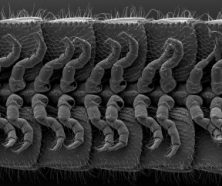Spotting the World’s Leggiest Animal
Researchers have rediscovered and studied a millipede with as many as 750 legs.
By Eric Jaffe
Although their name literally means “thousand legs,” most millipedes have no more than 300 legs. The record holder is a millipede named Illacme plenipes, which has nearly 750 legs. It’s the most legs ever observed on any animal.
You’d think it would be hard to lose an animal with so many legs, but that’s exactly what happened to this particular millipede. No one had seen one for 79 years until researchers recently spotted the critter in San Benito County, California, which is located several hours south of San Francisco.
 |
|
A rare California millipede may be the world’s leggiest species, but it moves slowly and grows barely as long as an entomologist’s thumb. |
| © Paul Marek and Jason Bond, East Carolina University |
There are more than 1,000 species of millipedes worldwide. Distantly related to lobsters and shrimp, these animals have four legs per body segment. They don’t bite, sting, or carry diseases. Luckily for many other creatures, they spend a lot of time eating dead leaves and recycling the nutrients into the soil.
In contrast, centipedes have two legs per body segment, and some have a dangerous bite.
I. plenipes was first observed in 1926 by a scientist who was one of the pioneers of millipede studies in North America. Later, when other specialists scoured the same small area in California looking for these millipedes, they came back empty-handed.
Part of the problem is that the leggy creatures are hard to see. Despite their many legs, adults measure less than 3.4 centimeters (1.3 inches) long and about half a millimeter (0.02 inch) wide.
“It’s pretty hard to immediately tell the difference between this tiny threadlike thing and a [plant] root hair,” says millipede expert Paul Marek of East Carolina University in Greenville, N.C.
Last year, Marek and his brother visited the area where I. plenipes had originally been found. They came around Thanksgiving during the rainy season, when millipedes, which like wet conditions, are more likely to crawl from their underground lairs to the surface. After about an hour of searching, they spied a moving squiggle. It was a living I. plenipes.
Marek says he was so excited that he was probably close to hyperventilating.
Over several more visits, the brothers and a colleague collected 12 millipedes (leaving at least as many behind). The adults had between 318 and 666 legs.
 |
|
The millipede’s legs are tiny. This magnified image shows that four legs are attached to each body segment. |
| © Paul Marek and Jason Bond, East Carolina University |
Females usually have more legs than males do, Marek says, and the millipedes probably grow additional legs as they get older.
The rediscovery of I. plenipes is wonderful news, says millipede expert Robert Mesibov of the Queen Victoria Museum and Art Gallery in Launceston, Tasmania. The island of Tasmania by itself has more than 160 millipede species.
It’s striking that I. plenipes appears to live within just one 0.8-square-kilometer patch of land. “If we’re serious about conserving biodiversity,” Mesibov says, “we need to pay attention to tiny natural areas.”
The only other millipedes that belong to the same family as I. plenipes live in Southeast Asia. That means these millipedes must have an unusual family history. The ones we see today may trace their family tree back to a time before today’s continents had split apart.—E. Sohn
Going Deeper:
Milius, Susan. 2006. Leggiest animal: Champ millipede located after 79-year gap. Science News 169(June 10):357-358. Available at http://www.sciencenews.org/articles/20060610/fob6.asp .
You can learn more about millipedes at www.smm.org/boghopper/Millipede.html (Science Museum of Minnesota) and en.wikipedia.org/wiki/Millipede (Wikipedia).
To compare centipedes, millipedes, and pill bugs, go to www.backyardnature.net/1000legs.htm (Backyard Nature) and www.myriapoda.org/ (East Carolina University).
Science project idea: What types of millipedes are found in your area? Where are they most likely to be found? How would you raise or care for millipedes?







